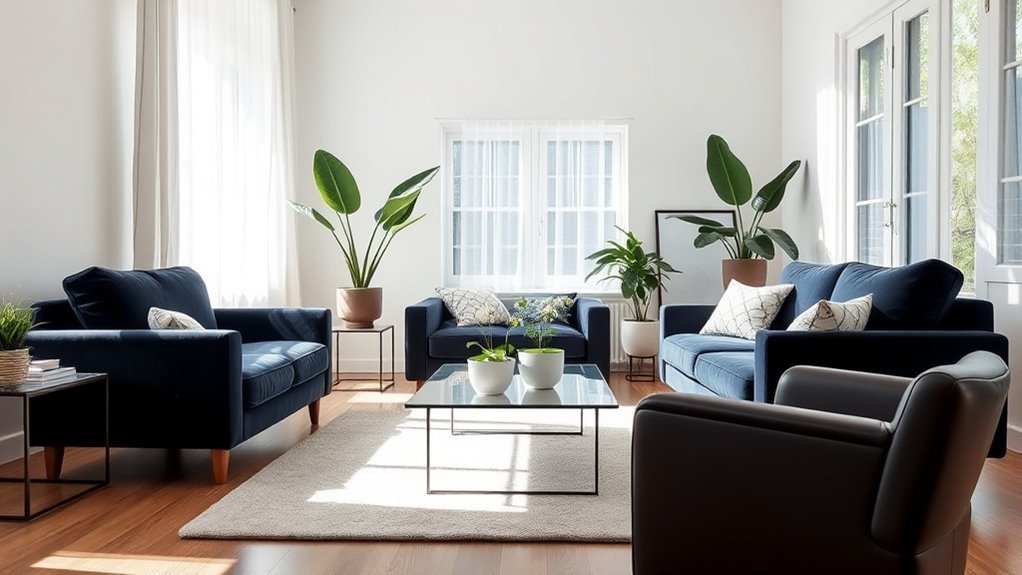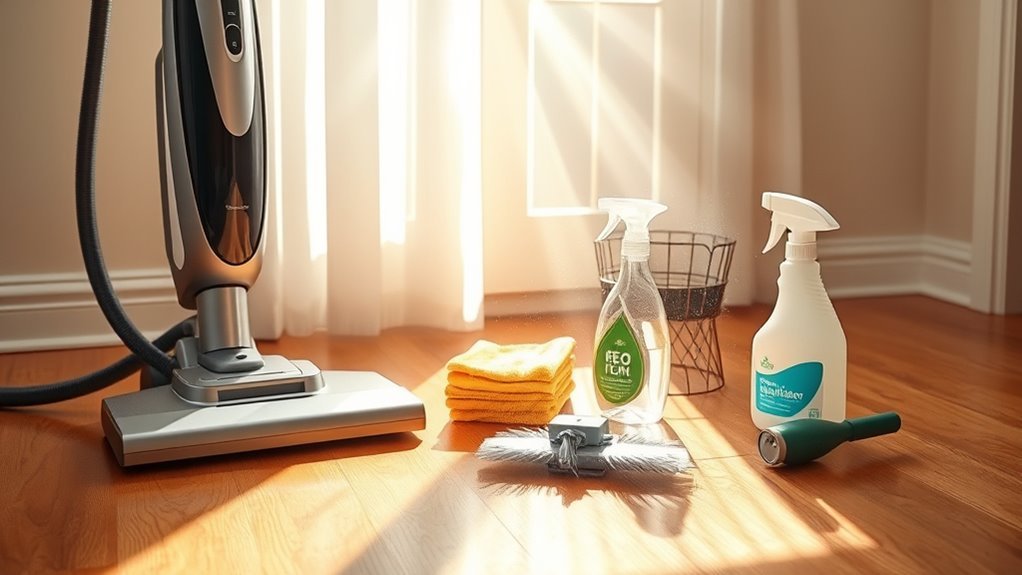How to Reduce Cleaning Costs in Dust
You can cut cleaning costs by setting up regular dusting routines that keep buildup at bay and save you time later. Using high-quality air filters and purifiers helps trap dust in the air, so surfaces stay cleaner longer. Choose dust-resistant furniture to lower maintenance, and improve ventilation by letting fresh air flow through your space. Pair these with effective cleaning tools like microfiber cloths and HEPA-filter vacuums for maximum results. Stick around to discover more ways to make dust your least expensive chore.
Implementing Regular Dusting Routines

Although it might seem simple, implementing regular dusting routines can greatly cut your cleaning costs. By setting a consistent dusting schedule, you’ll prevent dust buildup, reducing the need for deep, time-consuming cleaning sessions. Adjust your cleaning frequency based on your environment—dust more often in high-traffic or dusty areas, less in cleaner spaces. Sticking to this routine means you’re tackling dust before it settles, keeping your home fresher with less effort. This approach not only saves money on cleaning supplies and services but also frees up your time for what matters most. Taking control of your dusting schedule empowers you to maintain a clean, comfortable space without breaking the bank or feeling trapped by endless chores.
Using High-Quality Air Filters and Purifiers
When you invest in high-quality air filters and purifiers, you’re not just improving air quality—you’re also cutting down on cleaning time and costs. Different air filter types capture dust, allergens, and pollutants with varying efficiency, so choosing the right one helps maintain a cleaner environment effortlessly. Plus, purifier benefits include reducing airborne particles, which means less dust settling on surfaces.
| Air Filter Types | Purifier Benefits |
|---|---|
| HEPA | Captures 99.97% of dust |
| Activated Carbon | Removes odors and VOCs |
| Electrostatic | Attracts fine dust particles |
| UV Light | Kills airborne bacteria |
Choosing Dust-Resistant Furnishings and Materials

Investing in high-quality air filters and purifiers reduces airborne dust, but your furnishings and materials play a big role in how much dust accumulates on surfaces. When choosing furniture materials, opt for smooth, non-porous surfaces like leather or treated wood, which don’t trap dust as much as fabric. If you prefer upholstered pieces, go for dust repellent fabrics that resist particles and are easy to clean. These choices save you time and effort, giving you more freedom from constant cleaning. Avoid heavy textures like velvet or open-weave fabrics that attract dust and require frequent maintenance. By selecting dust-resistant furnishings, you’re not just cutting cleaning costs—you’re creating a more comfortable, low-maintenance space that fits your lifestyle perfectly.
Optimizing Ventilation to Minimize Dust Accumulation
Since dust tends to settle in stagnant air, optimizing your home’s ventilation can greatly cut down on how much you need to clean. By improving air circulation, you prevent dust from accumulating on surfaces, giving you more freedom from constant upkeep. Consider upgrading or maintaining your ventilation systems to guarantee they work efficiently, allowing fresh air to flow and push out dust particles. You can also use natural ventilation by opening windows and doors when weather permits, creating a cross breeze that sweeps dust away. Proper ventilation not only reduces dust buildup but also improves indoor air quality, making your space healthier and easier to maintain. Embracing good air circulation means less cleaning time and more time to enjoy your home on your own terms.
Employing Effective Cleaning Tools and Techniques

Choosing the right cleaning tools and techniques can make a huge difference in cutting down your cleaning time and effort. You want tools that work smart, not hard, so investing in quality microfiber cloths is a game-changer. They trap dust effectively without spreading it around, saving you multiple passes. Pair that with advanced vacuum technology designed to capture fine particles, and you’re minimizing dust buildup efficiently. These vacuums often come with HEPA filters, ensuring you’re not just moving dust but removing it completely. By using these tools strategically, you gain more freedom from constant cleaning chores, lowering costs over time. Embrace these methods to maintain a cleaner space with less hassle and reclaim time for what truly matters to you.
Frequently Asked Questions
How Does Humidity Affect Dust Accumulation?
You’ll find that humidity levels play a big role in dust accumulation. When humidity is high, dust mites thrive because they love moisture, which means more dust and allergens floating around. On the flip side, if it’s too dry, dust particles become airborne easier, making your space feel dustier. So, balancing humidity helps control dust mites and keeps dust from getting out of hand, giving you cleaner air and more freedom to enjoy your space.
Can Pets Increase Dust Levels in a Home?
Yes, pets can definitely increase dust levels in your home because pet dander adds to the particles floating around. You might think this means endless cleaning, but it doesn’t have to. By adjusting your cleaning frequency strategically, you can keep dust manageable without feeling trapped by chores. Embrace your furry friends and maintain a balance that lets you enjoy your freedom while keeping your space fresh and comfortable.
What Role Do Houseplants Play in Dust Reduction?
You’ll find that certain houseplant types can genuinely improve your air quality by trapping dust particles. Plants like spider plants, peace lilies, and snake plants are particularly good at this. They naturally filter the air, reducing airborne dust and allergens, which means less cleaning for you. Embracing houseplants not only frees you from constant dusting but also adds a revitalizing vibe to your space, giving you more time to enjoy your freedom.
Are There Specific Times of Day to Clean for Less Dust?
You might think dust multiplies like rabbits at dawn, but timing your cleaning can help. Morning cleaning is ideal because dust settles overnight, making it easier to wipe away before it stirs up. Evening cleaning, however, can leave dust unsettled all night, causing more hassle. So, if you want freedom from constant dust battles, stick to morning cleaning—it’s your secret weapon for a fresher, less dusty home.
How Do Seasonal Changes Impact Dust Cleaning Needs?
Seasonal changes definitely affect how often you’ll need to tackle dust cleaning. When seasonal allergens peak, like in spring or fall, dust tends to accumulate faster, making your space feel less fresh. Temperature fluctuations can stir up dust and allergens too, so you might notice more settling during these times. To keep your freedom from constant cleaning, you can adjust your routine based on these natural cycles and focus on ventilating your space well.






